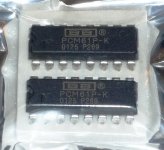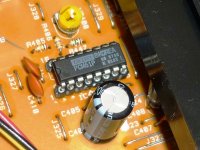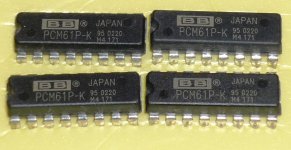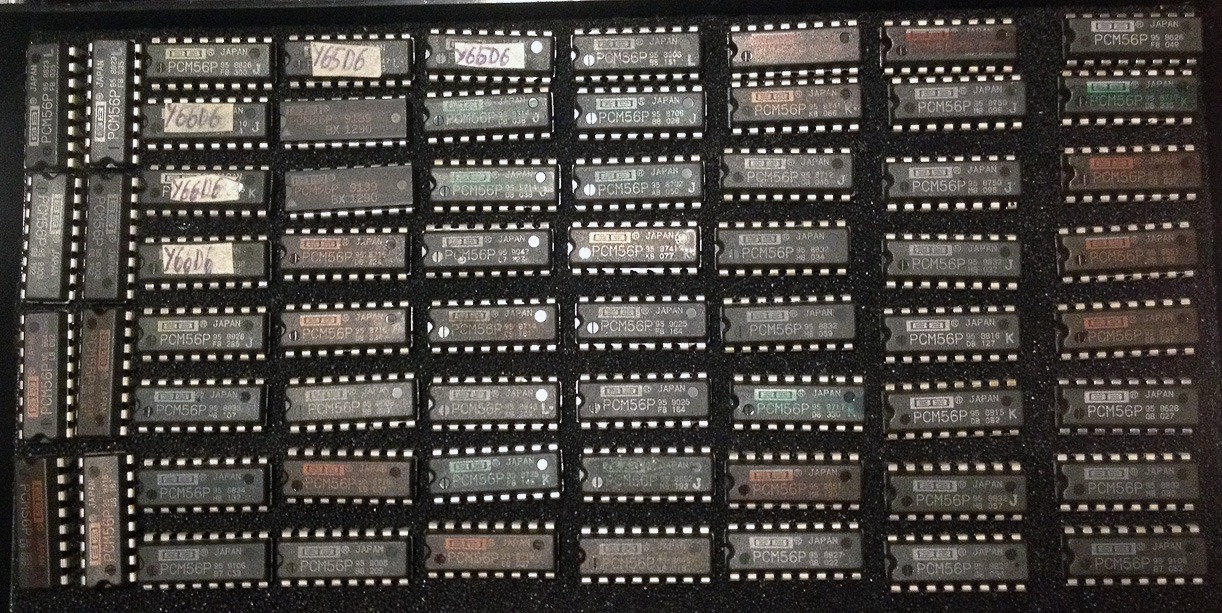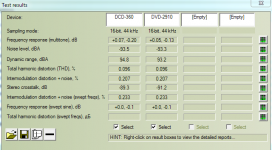Update - I just received another batch. Those are marked "Japan". Probably because are older, before TI aquired BB (september 2000)?
Does that mean that the 2001 from above are made in USA? I did put them in, they sound good. Very good...
Does that mean that the 2001 from above are made in USA? I did put them in, they sound good. Very good...
Attachments
Last edited:
They can be etched after the selection. I would think that, in that case, the packaging has to be done in the same plant as the foundry.
They work, so they are real chips. The "normal ones" that I had are painted, not etched - it would take serious effort to erase that paint and etch the new label.
I think they are "real"... but I wanted to hear other oppinions.
They work, so they are real chips. The "normal ones" that I had are painted, not etched - it would take serious effort to erase that paint and etch the new label.
I think they are "real"... but I wanted to hear other oppinions.
Well,
I was just saying what my research lead me to, you can probably have a look at this thread
http://www.diyaudio.com/forums/digital-line-level/121552-real-fake-pcm63.html
(better not, will take quite some time to read through). It is of course about the PCM63, might be different with the 61 but the idea was that they laser etch the logo and then when they grade it they use some kind of whitish ink to mark the grade. It will be sort of difficult to put them back for laser etching the grade again. The only important thing is how they sound though, I don't really care about the grade and I prefer to listen to them. From a batch of probably 60 K grades we could definitely hear differences in sound. My friend beauty_devine who started the thread has worked for Alcatel in actually making chips and he knows a thing or two about it, grading doesn't always mean better sound so I suggest you just enjoy them if they sound good. Sorry if that is not what you wanted to read but this is what I know about the grading.
I was just saying what my research lead me to, you can probably have a look at this thread
http://www.diyaudio.com/forums/digital-line-level/121552-real-fake-pcm63.html
(better not, will take quite some time to read through). It is of course about the PCM63, might be different with the 61 but the idea was that they laser etch the logo and then when they grade it they use some kind of whitish ink to mark the grade. It will be sort of difficult to put them back for laser etching the grade again. The only important thing is how they sound though, I don't really care about the grade and I prefer to listen to them. From a batch of probably 60 K grades we could definitely hear differences in sound. My friend beauty_devine who started the thread has worked for Alcatel in actually making chips and he knows a thing or two about it, grading doesn't always mean better sound so I suggest you just enjoy them if they sound good. Sorry if that is not what you wanted to read but this is what I know about the grading.
Last edited:
True, but that's not the way they did it in the old days. The grade was stamped on after the chips were assembled, labeled, and tested.They can be etched after the selection. I would think that, in that case, the packaging has to be done in the same plant as the foundry.
PCM61PK Photo
The chips may work but are they PCM61P-K. The 16-bit PCM56 has the same pinout.
Well you could try measuring the output of the DAC with a computer sound card. -92dB specification isn't all that 'impressive' most decent modern sound cards should be able to better that. As you've got several you could compare the measurements, they should theoretically all measure the same, the impulse responses should be the same, as should the frequency responses and the overall non-linear distortion plots.
I need a 991Hz test CD  A FFT software that can output that.
A FFT software that can output that.
RMAA, TrueRTA?
I have a Creative X-Fi Platinum card.
RMAA, TrueRTA?
I have a Creative X-Fi Platinum card.
Last edited:
Ah I see, so no digital input, that could make things a little more complicated in that you wont be able to do a number of tests, but you will still be able to look at a 1kHz test tone, that should be fairly decent. If the input to the sound card goes up to 192kHz you could also check the noise profile above 20k on the output of the DAC.
Looks like my sound card input cannot go below 0.096% THD on input. And loopback from line-out is even worse that playing a CD! Normal, the card has the crappy original OpAmps and a CL DAC.
I need a better ADC
And RMAA free does not analize wav with higher PCM than 44.1kHz and 16 bit. What other software can I use?
@Bernhard - do you have any PCM61P-K?
I need a better ADC
And RMAA free does not analize wav with higher PCM than 44.1kHz and 16 bit. What other software can I use?
@Bernhard - do you have any PCM61P-K?
Last edited:
That's cool, thank you. However it lacks a feature that RMAA has. It needs to be able to save as wav a "test" signal, that I can burn and play on my CD player. Then record via ADC to be analyzed in the software. RMAA does that, but the free version accepts (loads) only 44.1kHz/16bit input from ADC, and that limits the capability. My ADC has a slow roll-off filter at that sample rate -6dB at 20kHz, so I really can analyze only to 15kHz.
Plus, from my preliminary results, looks like I need a better soundcard (better THD on ADC part).
Plus, from my preliminary results, looks like I need a better soundcard (better THD on ADC part).
Attachments
Last edited:
Just use ARTA's spectrum analyser it will work with an external source, just set the input going and turn off the generator.
What ADC does the card use? That distortion seems unusually high, especially for what creative are marketing as a somewhat more upmarket card, usually they use decent converters.
What ADC does the card use? That distortion seems unusually high, especially for what creative are marketing as a somewhat more upmarket card, usually they use decent converters.
The "consumer" sound cards have usually given only the output specs (DAC). For X-Fi Platinum:
• Stereo Output 109dB
• Front and Rear Channels 109dB
• Center, Subwoofer and Side Channels 109dB
• Total Harmonic Distortion + Noise at 1kHz (20kHz Low-pass filter) = 0.004%
The ADC seems to settle THD=0.1% (at 44.1 kHz/16 bit) since two different players show the same value. I did try loopback on card and is even worse!? I will play latter with the other software, maybe is an operator error.
• Stereo Output 109dB
• Front and Rear Channels 109dB
• Center, Subwoofer and Side Channels 109dB
• Total Harmonic Distortion + Noise at 1kHz (20kHz Low-pass filter) = 0.004%
The ADC seems to settle THD=0.1% (at 44.1 kHz/16 bit) since two different players show the same value. I did try loopback on card and is even worse!? I will play latter with the other software, maybe is an operator error.
I did try to set the X-Fi DSP master clock to 88.1 and 96kHz and it didn't do any change in results - looks like the DSP induced THD is really lower than that (they claim -140dB).
I did try to set the recording rate to 96kHz, but then the RMAA complained that the resulting files are not "PCM standard" and cannot use them...
I will try today using the ASIO options in the Creative software and maybe other recorder than the stock Creative one.
I did try to set the recording rate to 96kHz, but then the RMAA complained that the resulting files are not "PCM standard" and cannot use them...
I will try today using the ASIO options in the Creative software and maybe other recorder than the stock Creative one.
The ADC seems to settle THD=0.1% (at 44.1 kHz/16 bit) since two different players show the same value. I did try loopback on card and is even worse!? I will play latter with the other software, maybe is an operator error.
Maybe input level not high enough ?
- Status
- This old topic is closed. If you want to reopen this topic, contact a moderator using the "Report Post" button.
- Home
- Source & Line
- Digital Line Level
- Real or fake?
